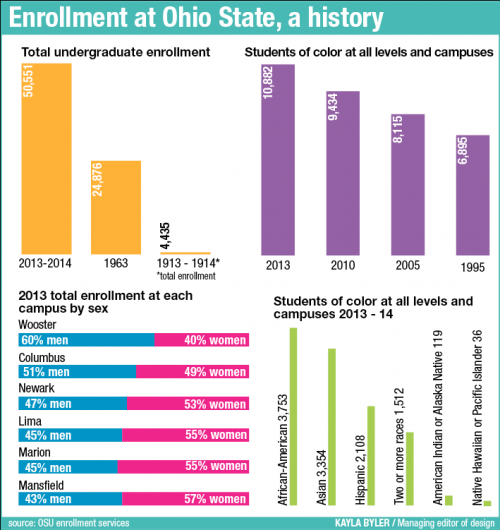With more out-of-state students and more students “of color” enrolled now than in years past, an Ohio State official said the challenge of striking a balance between catering to Ohio students and increasing diversity is growing.
The One University 2013-14 Enrollment Report summarizes enrollment at all OSU campuses and includes categorical comparisons between previous years’ enrollment statistics. The enrollment report includes information about undergraduate, graduate and professional students at the Columbus and regional campuses.
The report’s data show the statistical summary of OSU’s progress over the past few years, including a nearly 24 percent increase in the total number of undergraduate applications between 2012 and 2013.
The percentage of out-of-state students admitted at the Columbus campus during Fall Semester jumped to 21.2 percent in 2013 from 16.3 percent in 2012.
The percentage of enrolled “students of color” at all campuses also increased to 17 percent in 2013 from 16.3 percent in 2012.
Dolan Evanovich, vice president for strategic enrollment planning, attributed the changes to two things. The first, he said, was the university’s switch to the Common Application, an online application that allows students to apply to multiple schools with one application. Evanovich said the move “increases (OSU’s) visibility and access for high-achieving students from across the country and across the world to apply.”
He also said investments in recruiting across the state, country and world “have made a really powerful difference in students that are interested in OSU.”
OSU recruited in-state students in order to “keep the best Ohio students at Ohio State” and made investments to “attract qualified, really high-achieving students from outside of Ohio,” Evanovich said.
With increasingly challenging admissions requirements and higher academic standards, the number of enrolled students from Ohio has declined over the past several years and will continue to get smaller over the next few years, Evanovich said.
While Ohio residents made up 75.5 percent of the freshman class in 2012, they made up 71.7 percent of 2013’s freshman class, according to the report and OSU’s Undergraduate Admissions website.
As a result, there is an additional incentive to recruit students from across the U.S. and OSU has made its investments “to offset some of that decline of Ohio graduates,” Evanovich said.
Those investments include university-hired recruiters in Los Angeles, Houston, Atlanta, New York City and Chicago who work to attract high-achieving out-of-state students. Evanovich said.
OSU also established international gateway offices in Shanghai and Mumbai, India, and plans to soon recruit from its next international “landing pad” in São Paulo, Evanovich said.
OSU’s position as both a land-grant institution and diverse flagship university, though, is not without its challenges.
A land-grant institution is one that was designated by its state legislature or Congress to receive benefits of the Morrill Acts of 1862 and 1890. The original intent was for the schools to teach agriculture, military tactics and mechanics, as well as classical studies.
“OSU must hold both of those missions simultaneously, not one at the expense of the other,” Evanovich said, “that is the challenge for us as we move forward.”
Mikeisha Vaughn, a third-year in fashion and retail studies, said she values the progress OSU has made.
“Having a more diverse campus is conducive to the learning environment. It’s important to meet people from different walks of life,” she said.
Beth Statler, a second-year in biology and member of the OSU Latino Leadership Development Institute, said being part of a diverse campus is essential to learning and overcoming discrimination.
“We cannot continue surrounding ourselves by people who are only like us because in reality, the world is a large, diverse place full of so many interesting, different people. In order to get along with others who we may not agree with, we need to understand where they come from before creating judgments and stereotypes, because that would just fuel the discrimination that continues to occur today,” Statler said.
Evanovich said diversity is a “strategic pillar” for the university.
“Diversity for us is racial, ethnic, economic, geographic, gender. We look at all of the different diversity opportunities,” he said. “That’s why it’s important. It really enriches the experience of our students here.”
Evanovich said while there is currently no plan to create a numerical goal for a more diverse future on OSU’s part, the university aims to continue working to attract people of diverse backgrounds, in and outside of Ohio.
“We want to make the learning experience even stronger,” he said.



